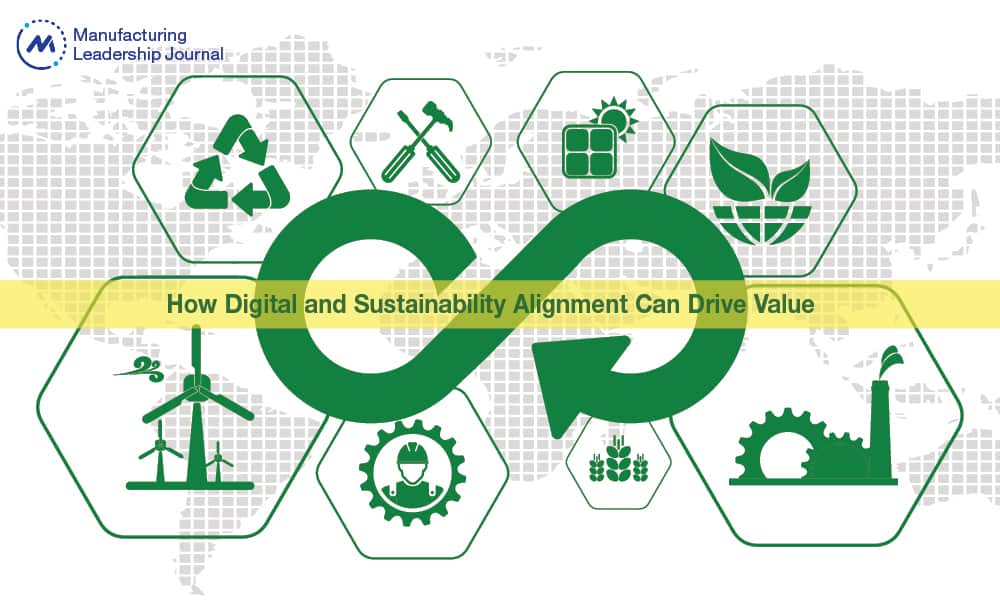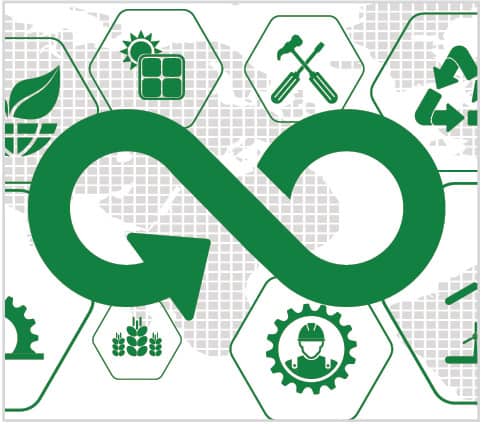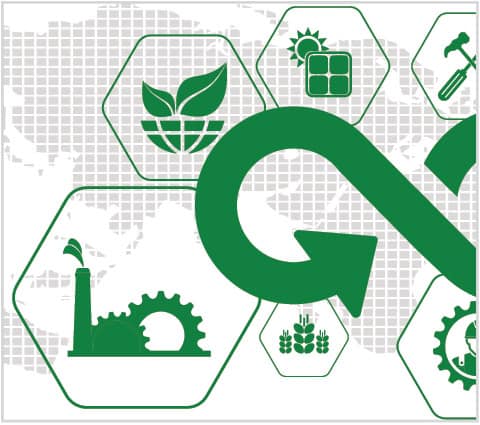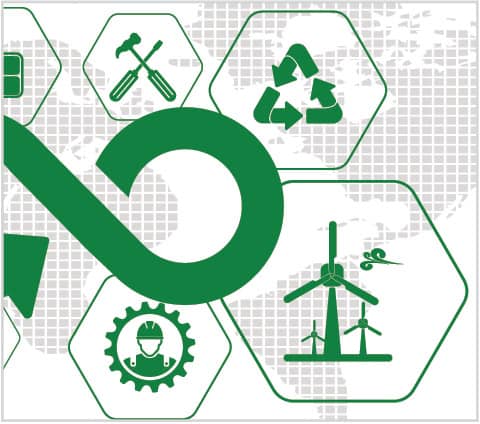How Digital and Sustainability Alignment Can Drive Value

Transformational journeys can go hand in hand to improve competitiveness and performance.

Nearly a quarter of U.S. greenhouse gas emissions come from industrial sources. Under mounting pressure to respond to investors, consumers, regulators, and employees alike, manufacturers have elevated sustainability to a board/C-suite level issue. In the January 2022 Climate Action 100+ report, 87% of companies reported having board-level oversight of climate change. While nearly 4,000 companies are acting on climate change, only one-third of them have set a net-zero emissions commitment, a near even split between enterprise (800 out of Global 2000) and mid-market (700 out of millions of SMEs).
A significant majority (87%) of respondents in the 2021 MLC M4.0 Sustainability and Net Zero survey said they believe the industry has a special responsibility to society to become more sustainable. Above all else, it’s the right thing to do — but it’s also a matter of business viability. Various studies, such as that by the IBM Institute for Business Value, find that consumers increasingly make buying decisions based on sustainability and are willing to pay more for products branded as sustainable or socially responsible, particularly Generation-Z and high-income shoppers.
Manufacturers are answering the call. In last year’s MLC sustainability survey, about a third of respondents said they already have publicly shared net-zero targets. Additionally, management’s focus on sustainability and net zero strategies increased at a third of companies. We are interested to see how that metric moves in this year’s survey, given recent economic developments.

Above all else, sustainability is the right thing to do — but it’s also a matter of business viability.
Anecdotally, we’ve heard from several manufacturing clients that sustainability initiatives and investments will have to take a back seat as their organizations prepare for the prospect of a recession or slowdown. Given sustainability’s overall impact on future business competitiveness, that’s a concern.
Maintain Momentum, Despite Uncertainty
The factors that initially made sustainability a top-tier priority are not going away. Driving toward net zero will be a long journey, likely over many decades with peaks and troughs in the business and economy over time. Focusing on sustainability can be beneficial for navigating rough economic periods — for example, reducing waste can also improve the cost of goods sold. And when the economy does turn positive, companies that can demonstrate progress will only have strengthened their competitive position.
Manufacturers already are seeing the value of becoming digital, because digital businesses perform better. We believe that aligning the digital journey with the sustainability journey can advance both goals and drive greater overall return on investments.
Focus Beyond the Four Walls of Manufacturing
Moving toward net zero certainly starts inside the factory walls. This is where being digital comes in. In the 2021 MLC sustainability survey, 52% of respondents said they believe M4.0 technologies will be significant to reaching sustainability targets.
Approaching digital manufacturing with a sustainability lens can help reduce waste, emissions, and costs. Industrial IoT sensors can be used to gather data that enables insight into optimizing energy usage. This allows companies to reduce energy costs and the associated emissions.
Similarly, AI-powered process controls can reduce defect rates, which in turn reduces waste. For example, Schneider Electric’s smart factory in Lexington, Kentucky, leveraged Industry 4.0 technologies to capture greater energy consumption granularity and leveraged IoT connectivity with power meters and predictive analytics to optimize energy cost. The result? Reduced energy consumption by 26%, net CO2 by 30%, and water use by 20 percent.
There are also significant opportunities to add to the impact outside of the factory and across the value chain:
Supply chain: Stakeholders hold manufacturers responsible not just for their own environmental footprint but also for their suppliers’. Establishing a strategy for sourcing sustainable products is key to reducing Scope 3 emissions. For example, Flex set sustainability goals in 2021 that included the commitment that a portion of customers and suppliers share responsibility for reducing Scope 3 emissions. The company invited preferred suppliers to disclose emission data through a questionnaire and then used that insight to provide appropriate education and resources to its suppliers. In the first year alone, 29% of preferred suppliers established their own emissions reduction targets.

Aligning the digital journey with the sustainability journey can advance both goals and drive greater overall return on investments.
Green IT: Enterprise technology accounts for 1% of global greenhouse emissions. This is driven primarily by the production of end-user devices such as laptops, printers, and smartphones. It’s important to work with vendors to reduce these emissions by employing green initiatives such as optimizing device use to extend the life cycle, consolidating the applications footprint, and moving to cloud providers that power data centers through renewable energy.
Circular economy: A growing number of manufacturers are committing to a circular economy. Dow recently announced its accelerated commitment to deliver 3 million metric tons per year of circular and renewable solutions by 2030. The running shoe company On offers a subscription-based model through which customers wear the shoes for a certain period of time and then return them. Used shoes are disassembled, recycled, and used as raw materials for new shoes.
Smart products: Smart products are not just digitally connected. They employ data and analytics to improve the performance of a physical product over time. For example, a smart thermostat in a facility has connected motion sensors that record activity levels. Analytical tools then use that data to learn patterns and optimize settings, helping reduce the facility’s electricity consumption. Philips is using digital technology to capture product life cycle information to reduce waste and extend the life of its products such as X-ray machines. According to the IDC, by 2024, 80% of global manufacturers will incorporate environmental sustainability into their product life cycle management process and ecosystem, improving sales by 3%.
Large manufacturing enterprises are making advancements in most of these areas. While the mid-market may not have the resources that larger companies do, some companies — such as the Cooley Group — are setting the pace for peers.
Getting on the Track to Net Zero
We see opportunities to advance both digital and sustainability goals by focusing on four key areas:
Strategy: The journey begins here. In the 2021 MLC survey, half of the respondents said their company has a formal corporate sustainability strategy in place, up from 39% in 2019.
We believe a sustainability strategy should include:
- A moonshot vision (here’s a great example from Patagonia: “Build the best product, cause no unnecessary harm, use business to inspire and implement solutions to the environmental crisis”)
- Ambitious goals such as net zero ahead of competition, zero waste
- A data-driven estimate of emissions footprint around Scope 1, 2, and 3
- Inventory of current and future sources of emissions
- Climate mitigation initiatives
- Roadmap and an execution plan to meet your objectives
These goals and the roadmap should be communicated through sustainability reports and become part of standard operating procedures.

Sustainability metrics require many pieces of data from many sources, and that data often resides in many formats.
With our clients, particularly manufacturing companies, most are early in the adoption curve where they are formulating their sustainability strategy and finding ways to embed it in their organization.
Data: To manage change and demonstrate progress, you must be able to measure the impact of your efforts. This remains a barrier for many organizations. Sustainability metrics require many pieces of data from many sources, and that data often resides in many formats. This is a significant effort that requires a high degree of manual activity for most.
Manufacturers need to accelerate their ability to use data for the good of the business, not just sustainability. A good starting point is an assessment that identifies the data required to measure total emissions, determines where that data comes from, and documents how you access and gather it today. You can then look for opportunities to automate data collection.
For example, if you need utility information for many locations, create an app that pulls in the necessary information rather than having someone collect it via email. Such improvements are simple solutions that don’t require a substantial amount of time or new investment.
Data governance is also critical, and often overlooked. It’s focused on managing data assets and is critical around sustainability-related data sets such as energy or supplier data to enable data-driven decision-making. This is particularly important because you can’t improve what you can’t measure.
We believe a common set of governance principles such as the Data Management Association (DAMA) framework help organize the function and enables it to understand sustainability goals, identify data sources, and build the right framework for automation.
Begin looking at how to use analytics to increase impact and progress toward goals as data capabilities mature. Keep it simple, but know that the potential is vast. For example, Vestas Wind Systems, a Danish wind turbine manufacturer, used data and analytics and modeling grids with weather data to pinpoint the optimal placement of each turbine. The analysis not only helped reduce the time required for site development, it also reduced energy costs for utilities and consumers.

Begin looking at how to use analytics to increase impact and progress toward goals as data capabilities mature. Keep it simple, but know that the potential is vast.
More mature data capabilities will also enable you to reap sustainability benefits from smart products. For example, John Deere is connecting their farm equipment, such as tractors and combines, to help farmers make the right choices on fertilizer and pesticide usage and conserve water during irrigation.
People and leadership: Being digital is not just about technology. It is equal parts people and processes. In the 2021 MLC Sustainability survey, more than 60% of organizations said they have a dedicated sustainability team, up from 51% in 2019.
Elevated leadership, with a senior executive designated to oversee reporting and progress — if not specific initiatives — is also critical. Many large organizations have an established senior leader, such as a chief sustainability officer, but it’s still common to see responsibility for action embedded in different functions such as IT or procurement. A senior leader must have the influence and authority to generate support from various department heads.
Don’t underestimate the organizational change management required. Employees should understand the “why” associated with changes — for example, how new automation is not only driving efficiency but also reducing waste or emissions. Effective change and communication initiatives can also help engage interested employees in driving awareness and action among colleagues.
Supply chain: Increasing visibility into the supply chain has become a top priority for many organizations in light of recent disruptions. The same steps your organization is taking to engage suppliers in a digital supply chain can also provide a platform for gathering the data you need to measure overall corporate environmental impact. While the focus today is on improving capabilities for tracking and reporting supplier data, that will change. We expect that the standard will soon be demonstrating how you’re reducing environmental impact with preferred suppliers with strong sustainability metrics.
If you aren’t doing so today, it is time to begin working with Tier 2 and Tier 3 suppliers to track and report against sustainability targets. Don’t leave it up to them to determine what to report. Set out your requirements, and then provide guidance and support in fulfilling those requirements.

Effective change and communication initiatives can also help engage interested employees in driving awareness and action among colleagues.
Tools such as a portal for entering information can help reduce effort on both sides—without significant investment. As you progress in establishing methods for tracking and reporting, consider incentives, such as preferred status, for good reporting practices and/or metrics. As you enter new supplier relationships, do so with an eye toward building reporting and metrics into new agreements. Procurement should move beyond cost-benefit analysis for sourcing to include sustainability-related metrics such as embedded emissions and year-over-year change — as well as third-party rating/certification on labor use for manufacturing.
Finally, if your organization is a supply partner to larger manufacturers, be open to dialogue and willing to collaborate to meet mutual goals.
Keep Going
While economic pressures on costs are understandable, pausing efforts will impede progress, and demonstrating progress will be even more critical than it is now when the economy returns to a growth mode. Look for opportunities to continue delivering small wins, working in tandem with efforts to become digital across all aspects of the business. If your focus is scattered due to too many priorities or you’re unsure where to begin, find outside expertise to help advance areas that may be holding you back — such as your ability to gather and use data to manage and measure against goals. M
About the authors:

Randal Kenworthy is a Senior Partner, Consumer & Industrial Products, at West Monroe

Durgesh Patel is a Senior Manager, Consumer & Industrial Products, at West Monroe